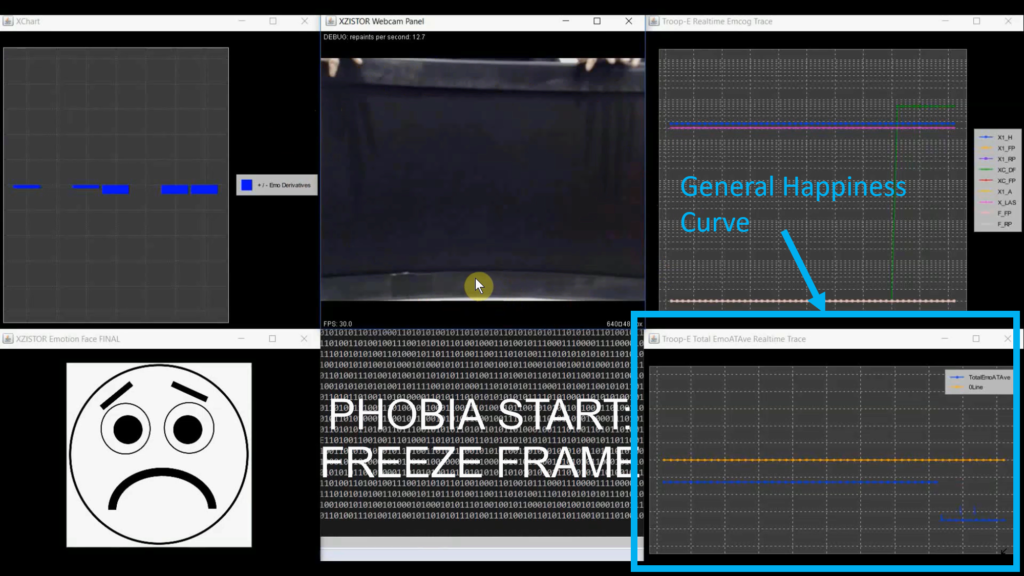
[Please note this is a ‘workbench’ project which means it is currently work in progress.]
When we look at the Xzistor Concept brain model running on a laptop and providing a robot with an artificial thinking, feeling brain – it is always interesting to look at the real-time graphs on the dashboard. Often in the demo videos I will refer to the General Happiness Curve in the right bottom corner. Do not be deceived by the frivolous name of this graph – it performs some of the most powerful transactions ever achieved in brain modelling.
It comprises of a simple blue line that either runs above or below an amber reference (zero level) line. The further the blue line moves above the amber line, the happier the robot is. And the further the blue line moves below the amber line, the unhappier the robot is.
What you see on that graph is a real-time summation of all that is good and all that is bad in the robot’s brain – this includes physical states, feelings, pain, fear, phobias, reflexes, associations and thoughts – even hunger. Using its special algorithm it calculates the average happiness level – positive or negative – and clearly tells us how happy or unhappy the robot is at any given point in time.

Those of you who are a little more mathematically-minded will know that the area under this curve (the integral) will provide us with the cumulative happiness(if > 0) or unhappiness(if < 0). Isn’t it amazing that we can watch a robot go through its life and keep track of instantaneous and cumulative happiness/unhappiness?
This simple graph as led me to many insights!
One of these insights is what death means in mathematical terms. When the robot is switched off, it effectively dies or terminates and the graph records a constant 0 level. This means there is no happiness and no unhappiness beyond the point of termination.
This curve could indicate to us the quality of life the robot has. If we could do the same with the human (biological) brain, we would be able to measure physical and emotional suffering in real time of a dying person. We would expects the dying individual to start showing considerable emotional stress upon learning that they are terminally ill or dying. This is not to say there might not be happy moments in-between, but these could well be dominated by physical pain and emotional stress, fear, humiliation, loneliness, rejection, anxiety – and often depression.
If it was a robot we would be able to mathematically calculate when the robots life would become predominantly unhappy – as the net curve integral will be negative (i.e. area under the curve larger than the area above the curve). This means the General Happiness Curve is net negative (-). This simply means the life of the robot is an unhappy experience and not a happy experience – it is net more bad than it is good.
That would beckon the question – is their any point in extending the life of the robot beyond that point if it is only going to be bad, unhappy, severely unpleasant?
We as humans will often battle on in the belief that we might be cured, things will get better and we will feel better again – and this keeps us going. In spite of the suffering there is also the patent fear of death (which is another brain state which is explained by the Xzistor Concept in mathematical terms) which will make us choose the suffering no matter how harrowing or dehumanising.
But some people believe that humans have the right to choose to terminate their own lives (albeit sometimes with the help of others). Mathematically this makes sense – as the terminal phase could well be known and explained to them and there could be no prospects of less pain and less suffering and less humiliation. By terminating their lives the negative area under the curve is reduced to 0 and the net suffering will also be 0. This is mathematically better than existing with a negative net reading. It is better for the suffering individual to not exist.
Many people, even before this perspective from a working brain model, believe humans have the right to terminate their own lives as no-one other than they themselves own their lives. They were never asked if they wanted to be in this world – it was forced upon them either by accident (some say 90% of births) or by eager awaiting parents looking forward to have something to love and care for, and importantly, something to love them back, give them a sense of purpose and remove that deep instinctive yearning not to go through life alone. Because of this simple fact humans come into this world planned or unplanned having no choice in the matter, often born into poverty, violence, physical and mental abnormality, ideological and religious oppression, neglect, sickness and other types of suffering – often the consequences of the carelessness or selfish needs of other human beings.
For society to preach to these individuals that they are not legally permitted to end their lives is just mind-blowing to me. Who decided this? Who has more say over their lives than they themselves?
What is slightly amusing to me is how we as a humanity can look back at the colonial days and ask: ‘How could we do that? What were we thinking? Did we not see that it was wrong?’
At the same time we are committing a similar atrocity by not acknowledging the right of ownership of individuals of their lives.
Opposing euthanasia is primitive, if not barbaric. We look at someone and say ‘You are going through unspeakable misery and pain but you are not allowed to end your own life, even if science indicates it will only get worse and then you will die in any case…’
The Health Professionals Council of a country I will not name here recently appealed against a judgment by a High Court judge to allow euthanasia, with their statement ending: ‘The prohibition of voluntary euthanasia protects the vulnerable and society against this evil.”
Do we not see that this is wrong? It should be a criminal offense not to allow someone to end their own life?
Of course if there is a reasonable prospect of recovery – one would encourage individuals to try and battle through the temporary set back. I am also not saying stop doing the great work to understand and eradicate anxiety, stress, depression, addition, etc. But we do not own the lives of others – only they can own their lives.
At the same time it is not unreasonable to expect of an individual planning to end their life to do it in a responsible way which does not infringe upon the rights of others. If we go this way, we will also have to look at this control and abuse avoided e.g. through regulation and codes of practice.
For instance, you cannot expect for life insurance providers to stick with the current model of risk assessment and suddenly accept suicide as a legitimate basis for a claim. This will make their model unfeasible and they will stop offering their services.
Also, you will have to secure a clear written request from the individual who wants to terminate their life – to request / authorise another party to implement their last wish.
We are allowing humans to travel into space and sending probes to explore the furthest planets in our solar system – but still have both the ignorance and arrogance to hold this notion that someone is not allowed to decide their own fate – even criminalising it and taking legal action against doctors asked by a patient to bring their suffering to an end.
I think we might well one day look back and think: ‘How did we not get it!?’

The video above is from an interesting article on BBC News.
PS: Acting on a comment from a Labber last night, I watched a documentary on the Suicide Forest (Aokigahara) at the foot of Mount Fuji in Japan – where many people commit suicide every year. Then I thought how sad it is that people all over the world are forced to commit suicide in remote locations in many awful ways because it is either not ‘legal’ or ‘acceptable’ in their societies. It is my understanding that in some developed countries such as the Netherlands, Canada, and the US state of Oregon, voluntary euthanasia is legal. I think suicide should be made as stress-less and painless as possible will full support from the medical fraternity and modern technology.
Just in case you think I am ‘pro-suicide’ I want to make clear I am not. For the human brain that is absolutely obsessed with survival, to consider suicide is a very desperate state to enter into. I have, and will, do a lot to convince people not to take their own lives – but I will respect their decision.
I want to end off on a positive note.
The Xzistor Concept brain model also provides us for the first time with a mathematical explanation of the mechanism of depression. I might in future do a demo video showing how I can make a robot ‘feel depressed’ and what this means. I have been able to ‘change’ individuals who suffer from depression to some degree by using the insights from my brain model to explain how depression works. The change I saw was that individuals stop seeing their depression as a ‘mysterious dark force’ and rather as a bunch of nerve cells mindlessly pulling the wrong strings and unbalancing the brain and completely spoiling their lives – they realise it is all caused by a cowardly clump of nerve cells. This ‘under the hood’ look at the mechanism of depression helps people get a physical understanding of their problem – and it spoils the hold depression has on their minds. It is a bit like – ok, the secrets are out and depression’s ‘smoke-and-mirrors’ show is over. It is just a simple mechanism and if you cannot fix it mechanistically (drugs), you can do a lot to override it by basically putting it ‘mentally’ in its place. I am not saying anybody got cured from depression after these discussions – just that I saw some encouraging changes in people.
One of the main reasons I want to bring my brain model to the world is to deliver a blow to the scourge of depression, anxiety and mood disorders – and also eradicate the stigma around mental health. I am hopeful that my model will rewrite the handbooks on psychology!
Additional note: I was touched by this BBC article on a person in France that is asking to have his life ended by euthanasia (where it is illegal). He is so desperate that he has decided to live-stream his death…but this has now been blocked. Euthanasia (controlled) is not up for debate for me, but live-streaming on Facebook is an interesting point for discussion….please tell me what you think below!
Here is the BBc article: https://www.bbc.com/news/world-europe-54041566